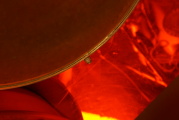Return to Kansas Cosmosphere
RD-107 Engine
The museum displays a Soviet-era RD-107 rocket engine. While there are four combustion chambers (six combustion chambers, when one includes the verniers which are technically part of this rocket engine but which are not displayed), there is a single turbopump and thus the RD-107 is considered a single rocket engine. The Soviets tried several larger designs with a single combustion chamber, but were unable to overcome combustion instability problems, and so they settled on the multiple combustion chamber system. These four combustion chambers are fixed (i.e., do not gimbal), and so two hinged verniers (powered by the same turbopump as the main combustion chambers) were added to the package.
Several Soviet missiles/rockets, going back to the R-7 and up to and including the current Russian Soyuz rocket (although this link inexplicably refers to the engines as "solid rocket boosters") have used a cluster of four strap-on RD-107s and an RD-108 center sustainer engine (which is very similar to the RD-107, but with four verniers). While the RD-107 has undergone a number of minor modifications over the years, it is largely the same engine today as it was in the late 1950s, making it the longest-lived rocket engine still in production.
The thrust quoted for the RD-107 varies from 178,000 lb to 183,000 lb to 204,000 lb to 228,000 lb. The two verniers each supply about 8,500 lbs of thrust, which may account for some of the variance (or perhaps the reported range is due to the engines having been uprated over time). Regardless, each combustion chamber puts out a bit less thrust than the 56,000 lbs of the V-2 missile engine. Certain versions of the Atlas missile (which had its first successful test flight in December of 1957 and its first orbital launch one year later) packaged two LR-89 thrust chambers together in an arrangement similar to the RD-107 (with shared turbopumps), which together produced over 300,000 lbs of thrust. (Ironically, modern versions of the Atlas rocket use the Russian RD-180 engine.)
Like the V-2 engine (and the RD-107's contemporary, the Redstone engine), it used a hydrogen peroxide steam generator to power its turbopumps and like the Redstone engine it had a long, cylindrical combustion chamber. The RD-107 improved on those engines by using RP-1 for its fuel (rather than a mixture of 75% ethyl alcohol and 25% water, the water having been added to keep combustion temperatures low enough to prevent burn-throughs on the thrust chamber walls) and having bell-shaped thrust chambers, rather than the longer (and heavier) conical thrust chamber.
The engine is displayed in the museum inside of a wall, with the thrust chambers' exit planes flush with the wall, preventing inspection of the bulk of the engines. The alcove is covered with mirrored panels, which does permit indirect viewing of limited portions of the engine.
Return to Kansas Cosmosphere
















